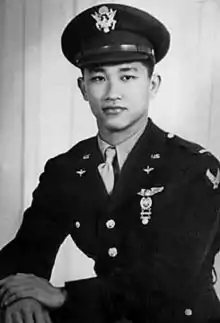Wah Kau Kong
Wah Kau Kong (Chinese: 江華九; January 17, 1919 – February 22, 1944) was the first Chinese American fighter pilot. Kong became a chemist after graduating from the University of Hawaii and joined the United States Army Air Forces after the Attack on Pearl Harbor. After completing flight school, Kong became a P-51 Mustang fighter pilot in England. He claimed 1.5 victories before being killed in action on a mission over Germany in late February 1944.
Wah Kau Kong | |
|---|---|
 | |
| Born | January 17, 1919 Honolulu, Hawaii |
| Died | February 22, 1944 (aged 25) over Blomberg, North Rhine-Westphalia, Germany |
| Buried | |
| Allegiance | |
| Service/ | |
| Years of service | 1942–44 |
| Rank | Second Lieutenant |
| Unit | 353rd Fighter Squadron 354th Fighter Group |
| Battles/wars | World War II |
| Awards | |
| Wah Kau Kong | |||||||||||||
|---|---|---|---|---|---|---|---|---|---|---|---|---|---|
| Traditional Chinese | 江華九 | ||||||||||||
| Simplified Chinese | 江华九 | ||||||||||||
| |||||||||||||
Early life
Kong was born on January 17, 1919[1] in Palama, a neighborhood of Honolulu. He was one of the five children of Yim and Mary Shee Kong. He graduated from McKinley High School in 1936.[2] Kong studied at the University of Hawaii, from which he graduated in 1940 with a bachelor's degree in chemistry, with honors. During his time at the university, Kong participated in the ROTC program. He competed in swimming, basketball, and track, while also taking flying lessons. Kong was working towards his master's degree in chemistry when he volunteered for military duty in early 1942, after the Attack on Pearl Harbor.[3]
Military career
World War II
He recorded the highest national score in his entrance examination and was accepted into the aviation cadet training program. Kong graduated from flight school in May 1943, becoming the first Chinese American fighter pilot.[3] He subsequently trained on the P-39 Airacobra, and on October 23 Kong boarded a convoy for England. He was assigned to the 353rd Fighter Squadron of the 354th Fighter Group at RAF Boxted, flying a P-51B Mustang, which he named "Chinaman's Chance" on one side and "No Tickee No Washee" on the other. On February 11, 1944, Kong claimed his first victory, an Fw 190, while returning from a bomber escort mission to Frankfurt,[4] which was his twelfth mission.[5] His victory was mentioned in Time magazine on February 28.[2]
Final Mission
On his fourteenth mission, Kong was shot down over Blomberg, Germany on February 22. Kong shared in a kill[6] of a Messerschmitt Me 410 with squadron leader Jack T. Bradley and was apparently hit by a stray bullet by the aircraft's rear gunner as Kong finished the plane off.[7] Kong's aircraft exploded and disintegrated in the air,[8] and his remains were buried by the Germans two days later.[9] In the early summer of 1945, after the end of the war in Europe, his childhood friend, Mun Charn Wong located his remains which were then re-buried at the Netherlands American Cemetery. After the war, Wau Kau Kong was re-buried in the National Memorial Cemetery of the Pacific, gravesite SECTION D SITE 453.[1] His friend Wong initiated the Wah Kau Kong Memorial Award Scholarship at the University of Hawaii in his honor.[2]
Military Awards
Kong's military decorations and awards include:
 | ||
| Badge | Pilot Badge | ||||||||
|---|---|---|---|---|---|---|---|---|---|
| 1st row | Purple Heart | Air Medal | |||||||
| 2nd row | American Campaign Medal | European-African-Middle Eastern Campaign Medal w/one bronze service star for the Air Offensive, Europe campaign. | World War II Victory Medal | ||||||
| Unit Award | Presidential Unit Citation | ||||||||
See also
- Art Chin, Chinese-American ace fighter pilot
References
Notes
- "Wau Kau Kong (1919 - 1944) - Find A Grave Memorial". www.findagrave.com. Retrieved February 1, 2017.
- Kakesako, Gregg K. (August 20, 1999). "WWII pilot not forgotten". Honolulu Star-Bulletin. Retrieved February 1, 2017.
- "Wah Kau Kong, The Nation's First Chinese-American Fighter Pilot". Congressional Record. 140 (149). 1994.
- Blake 2008, p. 78.
- Bealmear, Austin (February 14, 1944). "Lieut. Wau Kau Kong Gets First German Plane in Battle". Corsicana Daily Sun. Associated Press. p. 10. Retrieved February 1, 2017 – via Newspapers.com.

- Newton & Senning 1978, p. 308.
- "Air Force News". Northern Ireland Stars and Stripes. March 11, 1944. p. 2. Retrieved February 1, 2017 – via Newspaperarchive.com.
- Bradley, Jack T. (March 1, 1944). "Missing Air Crew Report 43-12393". Fold3. Ancestry.com. p. 5. Retrieved February 1, 2017.
- Blake 2008, p. 86.
Bibliography
- Honolulu Star-Bulletin, "WWII pilot not forgotten", by Gregg K. Kakesako, August 20, 1999.
- Speech by United States Senator for Hawaii, Daniel Akaka, commemorating Kong, August 20, 1999
- Time, "Kong Gets a German", February 28, 1944.
- Blake, Steve (2008). The Pioneer Mustang Group: The 354th Fighter Group in World War II. Atglen, PA: Schiffer Publishing. ISBN 978-0-7643-2925-8.
- Newton, Wesely P., Jr.; Senning, Calvin F. (1978) [1963]. USAF Credits for the Destruction of Enemy Aircraft, World War II, USAF Historical Study No. 85 (PDF). Research Studies Institute, USAF Historical Division, Air University.
